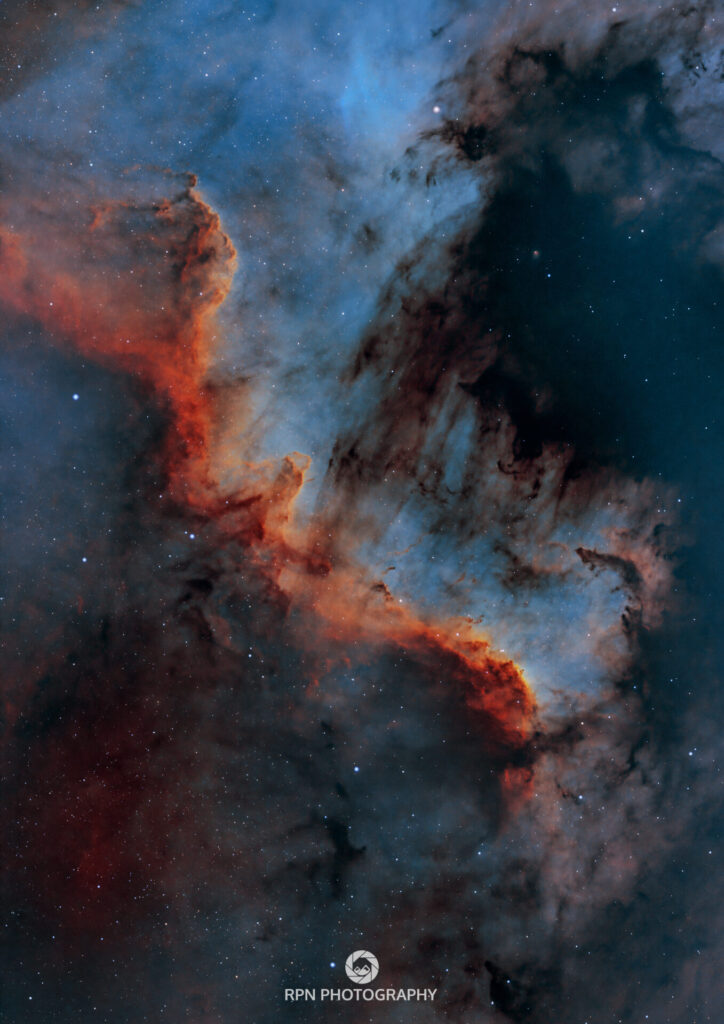Cosmic wonders from the Dorset skies as astrophotographer Rob Nolan captures the Cygnus Wall from 2,000 light years away

Happy New Year to all The BV readers! So here we are, 2024 – and I think every UK-based amateur astronomer had only one wish for Christmas – more clear skies!
The theme for the end of 2023 was, quite simply, atrocious weather! As I write, I’m really hoping we get to a decent cold snap quickly so we can finally get some clear crisp nights. I for one am far behind in my target list!
So, starting off our 2024 skywatch, we have an image I acquired back in late November, when we did actually have an entirely clear still night.
Long-standing readers may recall NGC7000 (The North America Nebula) from the middle of 2022. However, this image is a closer field of view, revealing fine details within the impressive ‘Cygnus Wall’ region of the Nebula. This is the portion of the nebula that oddly resembles Mexico and Central America! The ridge is approximately 20 light years long, and is a huge star-forming region.
To put things into perspective, when we talk about the distances of these deep sky objects and how far they are from Earth. Let’s just remind ourselves that a single light year is six trillion miles – that’s a six with 12 zeros behind it: 6,000,000,000,000 miles.
The North American Nebula is approximately 2,000 light years from Earth, just to really blow your minds this early in the year!
The North America Nebula in its entirety covers a region more than ten times the area of the full moon, but its surface brightness is low, so normally it cannot be seen with the naked eye. It took only three hours of data to create this false colour Narrowband image, which was captured using a dedicated mono astrophotography camera and a 1000mm Maksutov Newtonian reflector telescope, from our very own skies over Dorset.
The night sky, January 2024 – Rob’s guide for your stargazing this month:
celestial events, from meteor showers and comets to rocket launches. As we make another full revolution around our sun, 2024 will be an exciting year for astronomy!
Kicking off the year is a chance to see the return of an icy interloper that returns to our inner solar system every 6.2 years. Comet 62P/Tsuchinshan is a huge icy rock, more than 6 miles wide, and it will come within 47 million miles of Earth at its closest approach on 30th January. It will transit in front of the constellation Leo – you’ll need a dark sky to see it, and good night sky navigation skills or a computerized setup to find the comet in the night sky! There are several other comets that could be visible during February and March, so it’s a really exciting time for comet hunters! Come September we may get the chance to see another comet with the naked eye.
Turning our attention back to this month, we kicked off the year with the Quadrantid meteor shower on the 3rd and 4th – don’t worry, I missed it too!
On the 14th, look towards the Moon and you’ll spot Saturn close by shining brightly.
On the 18th, the brilliant star near the Moon will be our other gas giant neighbor, Jupiter.
On the 30th, grab those binoculars and try to find Comet 62P/Tsuchinshan in the Leo constellation.
There are some brilliant shining stars in the night sky at the moment, so why not take a tour of them? Find Orion in the night sky and you’ll see Betelgeuse and Rigel, accompanied by Sirius and Canis Major. Forming a giant arc above are Procyon, Castor and Pollux and Capella. You’ll also spot the unmistakable red giant Aldebaran. As the winter nights set in, the stars and constellations will become much easier to identify – but you’ll have to brave the cold to do so!
In other news
Fast forward to November and the Artemis 2 is NASA’s next step in the ambitious Artemis programme, which aims to put humans back on the Moon by 2025, to build a space station in lunar orbit and to lay the groundwork for sending humans to Mars. This crewed mission will fly beyond the Moon and complete a lunar flyby. A hugely exciting time for anyone born after the 1960s, with a taste of the adventure experienced during the Apollo programme – I can’t wait!
Until next time, clear skies.
Find Rob on Facebook as RPN Photography here

